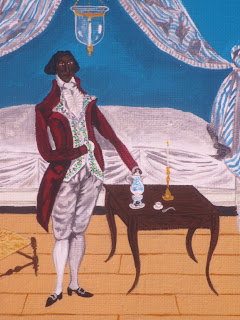"The Chamber of a Free man of color". Acrylic on canvas 16 x 12, Available.
My latest masterpiece is titled "The Chamber of a Free man of color". The inspiration for this painting came from a wonderful late 18th century miniature on ivery of a Free man of color from Saint-Domingue, now present day Haiti. The other inspiration for the painting is from a late 18th century Louisiana bedroom chamber of a free woman of color. The painting shows a well appointed circa 1790's bedroom chamber of a wealthy Louisiana free man of color. The focal point of the painting shows a 18th century Free man of color gentleman fashionably dressed in burgundy jacket, silk embroidered vest and gray satin breeches with buckled shoes.
late 18th century miniature on ivery of a Free man of color from Saint-Domingue, now present day Haiti. Note the wonderful gray painted carved Boiserie Paneling behind the gentleman. From the: Musée du Panthéon National Haïtien.
Miniatures of Toussaint Louverture & his family, Isaac Louverture, Placide Louverture & Claire Joséphine de Lacaze.From the: Musée du Panthéon National Haïtien
Late 18th century New Orleans collage painting, showing a dark skin Creole Free woman of color with her mix race Free man of color gentleman friend. Note the elegant furnishings and bed covered in French Toile de Jouy fabric.
Not all creole of color were mix race as some people believe. Creole come in all colors and hues. Under Spanish rule (1763-1803) in Louisiana a new law called coartación, which allowed slaves to buy their freedom, and that of others help to add to Louisiana's population of Free Creoles of color. The free people of color of Louisiana were on average exceptionally literate, with a significant number of them owning businesses, properties, and even slaves.
A late cream painted Neoclassical French Louis XVI style bedstead hung and draped in striped fabric.
He is standing in front of a French Louis XVI style bedstead hung and draped in striped fabric. Overhead is a hanging Glass Bell Jar Lantern. He is standing next to a mohangay Creole cabriole leg table holding a blue and white porcelain veilleuse. Also known as a nightlight teapot. These were used in the 18th to mid 19th c. A candle in the bottom kept tea warm & acted as a nightlight. Apparently it became popular when Napoleon (who didn't like to sleep in the dark) used them in his tent.
A Late-18th century Louisiana turned mulberry Slat-Back Side Chair with rush seat.
A mohangay Creole cabriole leg table.
Also on the table is a tea cup, silver spoon and brass Louis XV style candlestick. To the left of the gentleman is a Late-18th century Louisiana turned mulberry Slat-Back Side Chair with rush seat. Imported French furniture from Europe include the circa 1755 French ormolu-mounted Japanese lacquer secretaire-à-abattant to the right of the bed.
Circa 1755 French ormolu-mounted Japanese lacquer secretaire-à-abattant.
Lacquered objects are among the most highly treasured works of Asian art. Multiple, complex layers of lacquer are used to decorate the surfaces of screens, boxes, dishes, cabinets and small objects imparting a distinctive appearance that is also pleasantly tactile. With a history of production in Japan and China dating back to 5000 BCE, lacquerware began to be exported to Europe in the mid-16th century, where such objects were desired due to their uniqueness and great beauty. In the 17th century, European craftsmen began integrating panels removed from Asian lacquered screens into new pieces of furniture like the secretaire-à-abattant.
A framed portrait of a young slave in republican suit of the French Revolution.
Hanging over the secretaire-à-abattant is a framed portrait of a young slave in republican suit of the French Revolution. This is a portrait of a young black servant wearing a silver necklace of servitude, a three-colored (French) dress, and a hat with the republican cockade. By voting for the Declaration of the Rights of Man and of the Citizen in August 1789, the National Assembly proclaimed: “Men are born and remain free and equal in rights.” However, the question of slavery and the slave trade was little discussed in the debates and slavery in French colonies remained a cruel reality. It was not until the law of 16th Pluviôse the year II (on February 4, 1794) that the Republic granted full freedom to its former slaves.Even before 1789 critics had attacked the slave trade and slavery in the colonies.
France had several colonies in the Caribbean, the most important of which was Saint Domingue (later called Haiti). There were 500,000 slaves there in 1789 and they provided the labor for sugar, coffee, and cotton plantations. The behavior of slaves and the actions of slave owners in the colonies was regulated by a series of royal edicts, called the Code Noir, or slave code. The National Convention (the more radical assembly of the Jacobins that replace the Legislative Assembly in France) finally voted to end slavery in all the French colonies on February 4, 1794. Thousands of whites fled the island, and even the Mulattoes were not pleased. Many owned slaves themselves and were opposed to the move.
A giltwood Louis XVI mirror.
a giltwood Louis XVI carved marble top console.
A Dutch Delft tobacco jar.
To the left of the bad is a late 18th century Neoclassical giltwood Louis XVI carved marble top console with Louis XVI style mirror. On the console is a Dutch Delft tobacco jar. 16 x 12.
"The Chamber of a Free man of color". Acrylic on canvas 16 x 12, Available.
If you would like to follow the progression of my artwork and these paintings please visit and like my facebook page
Here



































This one is particularly charming, Andrew. And, as usual, I love all the history behind it. Well done!
ReplyDeleteThanks Stephilius, I enjoyed working on this one.
ReplyDelete